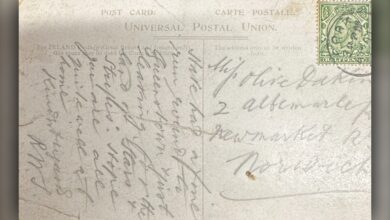A look at the world’s rarest diplomatic passport

The Sovereign Military Order of Malta – also known as the Knights of Malta – isn’t just a religious Catholic order with nearly 1,000 years of history. Nor is it just a multi-million-dollar-budget humanitarian aid organization, with operations including refugee camps and disaster relief programs in some 120 countries around the world.
It’s also a sovereign nation, with United Nations observer status and its own constitution, but, unusually, without any land. It issues car license plates – without having any roads to drive them on – and its own stamps, currency and passports.
The Knights originated as a chivalric order in Jerusalem around 1099 and were gifted the Maltese archipelago in 1530 by the King of Spain. Napoleon Bonaparte forced the Knights out of Malta in the French invasion of 1798, and these days the Order is headquartered in Rome. Daniel de Petri Testaferrata, the Malta-based President of the Order, tells CNN that only about 100 of the 13,500 knights, dames and chaplains now dispersed around the globe live in the Maltese archipelago.
The first passports were issued by the Order of Malta in the 1300s when its diplomats traveled to other states with documents attesting to their role as ambassadors. After World War II, the use of the diplomatic passport took on characteristics of passports used in other countries. Today, there are only around 500 of the diplomatic passports in circulation – making it the rarest passport in the world.
A very exclusive document
The Order’s crimson passport (perhaps a nod to the blood of Christ) is reserved for members of the Sovereign Council and leaders of diplomatic missions and their families. It’s adorned with gold lettering stating the organization’s name in French, “Ordre Souverain Militaire de Malte,” and a crest.
“The Order grants passports to members of their government for the duration of their mandate,” de Petri Testaferrata says. Grand Masters’ passports are valid for the longest period as they’re elected for 10 years, can serve two terms, and must retire by 85. Other passports are valid for four years and are only used for diplomatic missions. The passports have 44 pages watermarked with the Maltese cross without much other fanfare – no images or quotes.
Eugenio Ajroldi di Robbiate, the Order’s former communications director, tells CNN that it can be funny to see the reaction of customs officers when they see the passport. “They’ve likely never seen one before. Once when I arrived at the Bangkok airport, a crowd of operators at passport control wanted to see my rare passport and take a selfie with it,” says Ajroldi di Robbiate.
According to De Petri Testaferrata, two-thirds of Schengen members recognize the diplomatic passport and the Order works closely with many countries with no formal diplomatic relations such as France, the United Kingdom and the United States.
“We provide rapid medical and humanitarian supplies to victims of conflict or natural disasters. We run hospitals, ambulance corps, medical centers, homes for the elderly and the disabled, soup kitchens and first aid posts,” de Petri Testaferrata explains.
On the trail of Knights in Malta
While you’re unlikely to run into any Knights on a visit to Malta, there are many places across the Maltese Islands to learn about the fight and fate of the storied Order.
One of the first things you’ll notice as you arrive on the main island is the massive honey-hued Fort St. Angelo jutting out of the azure waters of the Grand Harbor. The imposing medieval bastion was once the Order’s Headquarters and is the only remaining structure on the island that still partly belongs to the Knights.
De Petri Testaferrata tells CNN the chapel dedicated to St. Anne in the upper part of the Fort is still cared for by the Order. You can tour this part of the fort to see where the Grand Master de Valette prayed daily for deliverance from the Ottoman invaders during the Great Siege of 1565.
Inside the ancient bastion walls of Mdina, Malta’s medieval capital and a UNESCO World Heritage site, you can learn more about the Order at “The Knights of Malta” 3D audiovisual show. It’s located in the Casa Magazzini where the Knights once stored ammunition and tells the Knights’ history in Malta, including when they were gifted the archipelago in 1530 by the King of Spain.
In the capital city of Valletta, you can continue your Knight trail at the National Library of Malta where the Pie Postulatio Voluntatis, the parchment Pope Paschal II used in 1113 to grant the Order sovereignty, is housed.
“The library’s collection consists of original documents and manuscripts of the Order,” Dane Munro, a tour guide and historian specializing in the history of the Order, says.
After the library, you can head across the street to the Grand Master’s Palace which once hosted the Knights. The Throne Room was used by the Knights as the Hall of the Supreme Council and remains adorned with ancient frescoes depicting the Great Siege. Don’t miss the portraits of Grand Masters in the Hall of Ambassadors.
Caravaggio’s time as a Knight
Like all good chivalrous gentlemen, the Knights loved fine art, leading to a controversy. Renowned Italian painter Michelangelo Merisi da Caravaggio arrived in Malta in 1607 after killing a man in a duel and fleeing Rome. The Order made him a Knight and he became the court painter. Shortly after Caravaggio showcased he was more of a brawler than a gentleman and the Knights expelled him from the Order.
While visiting St John’s Co-Cathedral, just a few blocks from the Grand Master’s Palace, keep an eye out for “The Beheading of St John” which is Caravaggio’s largest and only known signed work.
A few blocks away is the Casa Rocca Piccola of the de Piro family who were closely involved with the Order, according to Munro. You can take a tour of the grand home where Marquis Nicholas de Piro, the Chancellor of the Maltese Association of the Order, lives. His home is a time capsule of 16th-century Baroque elegance.
You can also stay in a palazzo that belonged to the Knights. Rosselli AX Privilege is a boutique hotel housed in the 17th-century home of Knight of Malta Don Pietro Rosselli and is centrally located in Valletta, making it the perfect home base as you tour around Malta to learn about the Knights.
If you get lucky and spot one of the few Knights on the archipelago, you might be able to identify them from their traditional robes, which are only worn during religious ceremonies. The black tunic with white cuffs features the eight-pointed Maltese cross. An additional decoration around the neck depicts the Knight’s rank in the Order of Malta.




